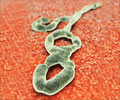A daunting challenge was faced when University of Texas Medical Branch at Galveston researchers set out to study Crimean-Congo hemorrhagic fever virus.

"It was completely new territory for us," said UTMB assistant professor Dennis Bente, senior author of a paper describing the BSL4 tick work in Frontiers in Cellular and Infection Microbiology. "Ticks are very small, and in the BSL4 you have two pairs of gloves on, you have this bulky suit, you have the plastic visor—all these things are a huge handicap. So how do you make sure you contain them?"
The answer: step by painstaking step. Bente and his collaborators first attached small "feeding capsules" onto mice, and then placed ticks of a species that carries Crimean-Congo hemorrhagic fever virus into the capsules. Unlike mosquitoes that feed quickly and fly off, most ticks attach and feed slowly over the course of several days. Once the ticks were attached and began feeding, they and the mice were moved into a room in the Galveston National Laboratory BSL4 set aside for tick research.
There, in a sealed glove box lined with sticky tape to capture any ticks attempting to escape, the mice were inoculated with Crimean-Congo hemorrhagic fever virus. The feeding-capsule enclosed ticks, each of which, tick by tick, was individually accounted for at every stage of the experiment, then acquired the virus when they fed on the infected mice.
"We did hours upon hours of testing to get this system working," Bente said. "We tested different types of sticky tape to determine the one that best inhibited the ticks' mobility, we tried different gloves, we tested the work flow, we checked to see how long a tick could last if you submerge it in disinfectant." (The answer: more than 24 hours)
The result, Bente said, is a tool that will give researchers a crucial window into a virtually unknown aspect of one of the world's most widely distributed hemorrhagic fever viruses— a pathogen responsible for outbreaks from Greece to India to South Africa. "Ticks play such a vital role in the epidemiology of the disease — they're not only the vector but they are also the reservoir for the virus, yet nobody really knows what's happening to the virus in the ticks, because there's been no way to study it in the laboratory," Bente said. "Now we can look at the complete transmission cycle in a controlled setting, examining how the virus is passed from infected animal to the uninfected tick, and from the infected tick to the uninfected animal. That's something that people studying this in the field haven't been able to do before now."
Advertisement
Source-Eurekalert















